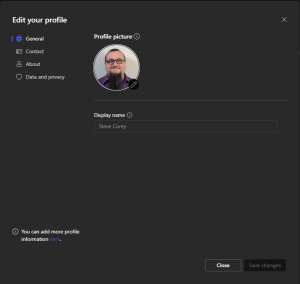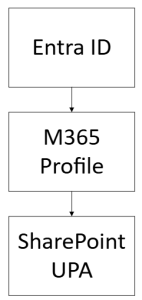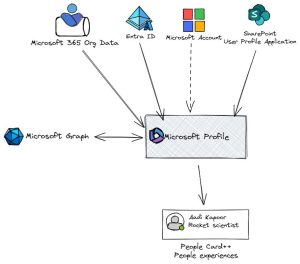The new user profile system for Microsoft 365 is starting to roll out. I’ve been checking it out, and it looks pretty good! It’s simple and effective, but it didn’t really fix one big issue. Before I get into that, I do want to highlight what this new solution does well, how it looks, and how to access it.
Welcome to the new M365 User Profile
To access this new system, navigate to office.com, and at the top of the page, search for your name.
to office.com, and at the top of the page, search for your name.
 Click on your name when it appears in the People section, and you’ll see a link that says “Update your profile”. This is the new system, and clicking on it will bring up a new profile editor.
Click on your name when it appears in the People section, and you’ll see a link that says “Update your profile”. This is the new system, and clicking on it will bring up a new profile editor.
Update any fields you’d like, although some fields can only be updated in Entra ID, and click save when done.
some fields can only be updated in Entra ID, and click save when done.
Simple, right? Now granted, not many people go to office.com, and that’s fine. Currently that appears to be the only place, but I believe this is rolling out to all other M365 surfaces where the Microsoft Search bar is present. Once that rollout is complete, you’ll be able to access your profile from many places, and that’s a good thing.
The Problem
Notice that some fields can only be updated via Entra ID. That part is understandable. Some fields (like Department) are controlled by IT, or potentially by an HR system. Those values need to be consistent and accurate. No problems with that staying in Entra ID. We all know that Entra ID administrators need all the help they can get with ensuring that Entra ID is accurate and up to date.
The problem is that we’ve still got a 3-tier hierarchy of user profile data.
3-tier hierarchy of user profile data.
Entra ID has some of data.
M365 User Profile has additional data
SharePoint UPA (user profile application) has the rest, including custom user profile properties.
This continues the confusion for both admins and users. Delve’s retirement presented Microsoft with a blessing: The opportunity to consolidate. Instead of storing user profile data in three different places, they could have moved the SharePoint UPA data into M365. Or, they could have kept the UPA but had it either synced from a M365 profile or it could have simply retrieved the values from the M365 profile. In either case, they would have simplified the architecture by eliminating an entire tier. We already have a complicated search architecture between SharePoint Search and Microsoft Search, with no sign of improvement. Couldn’t we have something simplified?
The problem really gets obvious when a user asks how to update one of their user properties. The answer is…. it depends. It could be one of 3 different locations within the Microsoft ecosystem. It could also be something they update themselves, or it may require an IT ticket. That’s not an ideal scenario.
UPDATE – 12/15/2024
Wictor Wilén, PM Manager in the FAST Services People Coherence team at Microsoft, provided me with a more accurate image depicting the flow of user profile data within Microsoft 365:
This shows a much flatter architecture. User data flows from many sources (including the SharePoint UPA) flowing into the M365 profile, where it’s then used to sync to Graph as well as exposed via profile cards in the UI. Thank you, Wictor!!
There’s Good News
The good news is that this interface, the one that replaces Delve, looks good. I believe it’ll be available in all Microsoft 365 surfaces where the Microsoft search bar exists. If that’s true, it’s even better, but unfortunately, we’re stuck with another complicated data structure instead of seizing the opportunity to make things simpler for both users and administrators.


